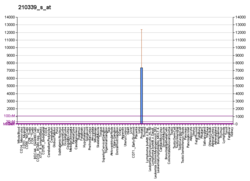Kallikrein-2
KLK2
Protein-coding gene in the species Homo sapiens
Kallikrein-2 is a protein that in humans is encoded by the KLK2 gene, and is particularly associated with prostatic tissue.[3][4][5][6]
Quick Facts Available structures, PDB ...
| KLK2 | |||||||||||||||||||||||||||||||||||||||||||||||||||
|---|---|---|---|---|---|---|---|---|---|---|---|---|---|---|---|---|---|---|---|---|---|---|---|---|---|---|---|---|---|---|---|---|---|---|---|---|---|---|---|---|---|---|---|---|---|---|---|---|---|---|---|
| |||||||||||||||||||||||||||||||||||||||||||||||||||
| Identifiers | |||||||||||||||||||||||||||||||||||||||||||||||||||
| Aliases | KLK2, KLK2A2, hGK-1, hK2, kallikrein related peptidase 2 | ||||||||||||||||||||||||||||||||||||||||||||||||||
| External IDs | OMIM: 147960 HomoloGene: 124422 GeneCards: KLK2 | ||||||||||||||||||||||||||||||||||||||||||||||||||
| |||||||||||||||||||||||||||||||||||||||||||||||||||
| |||||||||||||||||||||||||||||||||||||||||||||||||||
| |||||||||||||||||||||||||||||||||||||||||||||||||||
| |||||||||||||||||||||||||||||||||||||||||||||||||||
| Wikidata | |||||||||||||||||||||||||||||||||||||||||||||||||||
| |||||||||||||||||||||||||||||||||||||||||||||||||||
Close
- "Human PubMed Reference:". National Center for Biotechnology Information, U.S. National Library of Medicine.
- Riegman PH, Vlietstra RJ, Klaassen P, van der Korput JA, Geurts van Kessel A, Romijn JC, Trapman J (May 1989). "The prostate-specific antigen gene and the human glandular kallikrein-1 gene are tandemly located on chromosome 19". FEBS Lett. 247 (1): 123–126. doi:10.1016/0014-5793(89)81253-0. PMID 2468530. S2CID 37763337.
- Lundwall A, Band V, Blaber M, Clements JA, Courty Y, Diamandis EP, Fritz H, Lilja H, Malm J, Maltais LJ, Olsson AY, Petraki C, Scorilas A, Sotiropoulou G, Stenman UH, Stephan C, Talieri M, Yousef GM (Jun 2006). "A comprehensive nomenclature for serine proteases with homology to tissue kallikreins". Biol Chem. 387 (6): 637–641. doi:10.1515/BC.2006.082. PMID 16800724. S2CID 436200.
- Riegman PH, Vlietstra RJ, van der Korput HA, Romijn JC, Trapman J (1992). "Identification and androgen-regulated expression of two major human glandular kallikrein-1 (hGK-1) mRNA species". Mol. Cell. Endocrinol. 76 (1–3): 181–190. doi:10.1016/0303-7207(91)90272-T. PMID 1726490. S2CID 29689514.
- Qin H, Kemp J, Yip MY, Lam-Po-Tang P, Morris BJ (1992). "Localization of human glandular kallikrein-1 gene to chromosome 19q13.3-13.4 by in situ hybridization". Hum. Hered. 41 (4): 222–226. doi:10.1159/000154005. PMID 1783409.
- Schedlich LJ, Bennetts BH, Morris BJ (1988). "Primary structure of a human glandular kallikrein gene". DNA. 6 (5): 429–437. doi:10.1089/dna.1987.6.429. PMID 2824146.
- Frenette G, Deperthes D, Tremblay RR, Lazure C, Dubé JY (1997). "Purification of enzymatically active kallikrein hK2 from human seminal plasma". Biochim. Biophys. Acta. 1334 (1): 109–15. doi:10.1016/s0304-4165(96)00080-3. PMID 9042371.
- Bourgeois L, Brillard-Bourdet M, Deperthes D, Juliano MA, Juliano L, Tremblay RR, Dubé JY, Gauthier F (1997). "Serpin-derived peptide substrates for investigating the substrate specificity of human tissue kallikreins hK1 and hK2". J. Biol. Chem. 272 (47): 29590–29595. doi:10.1074/jbc.272.47.29590. PMID 9368023.
- Mikolajczyk SD, Millar LS, Kumar A, Saedi MS (1998). "Human glandular kallikrein, hK2, shows arginine-restricted specificity and forms complexes with plasma protease inhibitors". Prostate. 34 (1): 44–50. doi:10.1002/(SICI)1097-0045(19980101)34:1<44::AID-PROS6>3.0.CO;2-K. PMID 9428387. S2CID 23179822.
- Yu DC, Sakamoto GT, Henderson DR (1999). "Identification of the transcriptional regulatory sequences of human kallikrein 2 and their use in the construction of calydon virus 764, an attenuated replication competent adenovirus for prostate cancer therapy". Cancer Res. 59 (7): 1498–504. PMID 10197620.
- Mikolajczyk SD, Millar LS, Kumar A, Saedi MS (1999). "Prostatic human kallikrein 2 inactivates and complexes with plasminogen activator inhibitor-1". Int. J. Cancer. 81 (3): 438–442. doi:10.1002/(SICI)1097-0215(19990505)81:3<438::AID-IJC18>3.0.CO;2-U. PMID 10209959.
- Lövgren J, Valtonen-André C, Marsal K, Lilja H, Lundwall A (1999). "Measurement of prostate-specific antigen and human glandular kallikrein 2 in different body fluids". J. Androl. 20 (3): 348–55. doi:10.1002/j.1939-4640.1999.tb02528.x. PMID 10386814.
- Cargill M, Altshuler D, Ireland J, Ireland J, Sklar P, Ardlie K, Patil N, Lane CR, Lim EP (1999). "Characterization of single-nucleotide polymorphisms in coding regions of human genes". Nat. Genet. 22 (3): 231–238. doi:10.1038/10290. PMID 10391209. S2CID 195213008.
- Lövgren J, Airas K, Lilja H (1999). "Enzymatic action of human glandular kallikrein 2 (hK2). Substrate specificity and regulation by Zn2+ and extracellular protease inhibitors". Eur. J. Biochem. 262 (3): 781–789. doi:10.1046/j.1432-1327.1999.00433.x. PMID 10411640.
- Mikolajczyk SD, Millar LS, Marker KM, Rittenhouse HG, Wolfert RL, Marks LS, Charlesworth MC, Tindall DJ (1999). "Identification of a novel complex between human kallikrein 2 and protease inhibitor-6 in prostate cancer tissue". Cancer Res. 59 (16): 3927–30. PMID 10463585.
- Liu XF, Essand M, Vasmatzis G, Lee B, Pastan I (1999). "Identification of three new alternate human kallikrein 2 transcripts: evidence of long transcript and alternative splicing". Biochem. Biophys. Res. Commun. 264 (3): 833–839. doi:10.1006/bbrc.1999.1595. PMID 10544017.
- Ren F, Zhang S, Mitchell SH, Butler R, Young CY (2000). "Tea polyphenols down-regulate the expression of the androgen receptor in LNCaP prostate cancer cells". Oncogene. 19 (15): 1924–1932. doi:10.1038/sj.onc.1203511. PMID 10773882.
- Harvey TJ, Hooper JD, Myers SA, Stephenson SA, Ashworth LK, Clements JA (2001). "Tissue-specific expression patterns and fine mapping of the human kallikrein (KLK) locus on proximal 19q13.4". J. Biol. Chem. 275 (48): 37397–37406. doi:10.1074/jbc.M004525200. PMID 10969073.
- Chen VC, Chao L, Chao J (2001). "A positively charged loop on the surface of kallistatin functions to enhance tissue kallikrein inhibition by acting as a secondary binding site for kallikrein". J. Biol. Chem. 275 (51): 40371–40377. doi:10.1074/jbc.M005691200. PMID 10991942.
- Gan L, Lee I, Smith R, Argonza-Barrett R, Lei H, McCuaig J, Moss P, Paeper B, Wang K (2001). "Sequencing and expression analysis of the serine protease gene cluster located in chromosome 19q13 region". Gene. 257 (1): 119–130. doi:10.1016/S0378-1119(00)00382-6. PMID 11054574.
- Réhault S, Monget P, Mazerbourg S, Tremblay R, Gutman N, Gauthier F, Moreau T (2001). "Insulin-like growth factor binding proteins (IGFBPs) as potential physiological substrates for human kallikreins hK2 and hK3". Eur. J. Biochem. 268 (10): 2960–2968. doi:10.1046/j.1432-1327.2001.02185.x. PMID 11358513.
- Saedi MS, Zhu Z, Marker K, Liu RS, Carpenter PM, Rittenhouse H, Mikolajczyk SD (2002). "Human kallikrein 2 (hK2), but not prostate-specific antigen (PSA), rapidly complexes with protease inhibitor 6 (PI-6) released from prostate carcinoma cells". Int. J. Cancer. 94 (4): 558–563. doi:10.1002/ijc.1501. PMID 11745444. S2CID 2826757.




